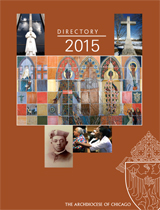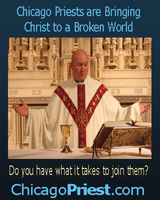June 8, 2008
Our Lady of the Sign unveiled St. Stanislaus Kostka Parish presents iconic monstrance as part of new Divine Mercy shrine
Nine years of prayer, work and faith culminated on the Feast of the Visitation, May 31, when curtains parted in the sanctuary of St. Stanislaus Kostka Church, 1351 W. Evergreen Ave., to reveal an iconic monstrance of Our Lady of the Sign, Ark of Mercy.
It’s just the beginning, however, of what will be the Sanctuary of Divine Mercy, the official shrine to the Divine Mercy devotion in Chicago.
Cardinal George was on hand to celebrate Mass and bless the new nine-foot, hand-carved and painted monstrance featuring Mary atop a gold-leaf decorated ark flanked by two kneeling angels, also in gold leaf, whose wings extend to shelter her. The 12-inch host, which had to be specially made for the monstrance, is encased in Mary’s center.
After Mass began Mercy Festival, a weeklong time of 24-hour eucharistic adoration.
Approximately 1,500 people packed into the church and its balconies to see the monstrance.
This intricately detailed and symbolladen monstrance is believed to be the world’s largest and was created by Polish sculptor Stefan Niedorezo. It was paid for by anonymous donations and royalties from the sale of “A Mother’s Plea,” the memoirs of Resurrectionist Father Anthony Bus, St. Stanislaus’ pastor.
“Everything that you see is unique,” said organizer Oscar Delgado, of the monstrance in an interview before the unveiling.
Each part of the icon has meaning, even the body positioning of Mary. She’s sculpted in a pose of exhale with her arms out and extended. It evokes a sense of release, calm when looking at her because she’s in a relaxed pose and makes it easier to pray, said Bus, in an interview prior to the unveiling. Marian Scripture is inscribed upon Mary’s clothes and other symbolism is worked in to the design.
‘Space of living faith’
For Malgorzata Sawczuk, a Polish conservator who hand-applied the gilding and paint to the iconic monstrance, working on the project was a spiritual experience.
“As I entered the attic of St. Stanislaus Kostka Church last year to see the Ark of the Covenant carved in linden wood by Stefan Niedorezo, a Polish master sculptor, I didn’t expect the kind of holy space the studio was to become for me: a space of true light and energy that always emanate from the world-class works of sacred art; but more so, a space of living faith emanating from the people I was to meet there every day, so deeply engaged in the hope of creating something beautiful for God - an iconic monstrance of Mary, the holy mother of God,” Sawczuk wrote in an e-mail.
“It was also an opportunity to bring alive some ancient painting techniques, almost extinct today, while most appropriate for the idea of the whole project. First of all, however, it was an opportunity to serve the realm of Christian mystery, opening a different, wider and deeper dimension to the vocation of the artist,” she wrote.
Walk in faith
The entire project for the monstrance and the future Sanctuary — which will be built between the church and school — came out of a message from Mary that Bus writes about in “A Mother’s Plea” where she asked him to dedicate the parish to her. When Bus received the prompting, St. Stanislaus was in poor shape. The building was in disrepair and the neighborhood poor.
It wasn’t always that way. At the beginning of the 1900s, St. Stanislaus was the largest parish in the archdiocese and in the country — boasting more than 40,000 families as members. Many neighboring parishes began out of the need to accommodate this large population. Founded in 1867, the parish was the first in the archdiocese with an apostolic mission to Polish immigrants.
Today, the parish continues to offer Mass in Polish but offers it in English and Spanish as well and has seen an influx of Hispanic immigrants in recent decades. And it hopes to serve many more through the shrine to Divine Mercy.
Architectural drawings for the sanctuary buildings are complete. Bus and his group worked with Denis McNamara from the archdiocese’s Office for Divine Worship on the design. It, in itself, will be a lesson in Scripture through architecture. Every placement of columns, every arch and every point relates to some part of the Bible.
But before building begins, they must raise $20 million.
“We’re walking on faith,” said Bus in an earlier interview.
But they are not walking alone.
Elizabeth Murray came from St. Vincent Ferrer Parish in River Forest to see the unveiling. She said she’s moved by what is going on at St. Stanislaus and the work of Bus.
“I think he’s encouraging people to have a devotion to the Divine Mercy. It’s inspiring,” said Murray.
Michael Kendall sees the iconic monstrance and sanctuary as part of a reawakening in the Catholic Church since the Second Vatican Council.
“It’s my hope that in 200 or 300 years that historians will look back at this time of awakening in the Catholic Church and say St. Stanislaus Kostka had a significant role to play in bringing about this great Catholic awakening,” said Sullivan, who took a 50 percent pay cut to come and work parttime as director of mission advancement for the Sanctuary of the Divine Mercy.
He also hopes that people who will be drawn to the monstrance by its beauty will be transformed to see that true beauty lies with Jesus in the Eucharist and that Christ can heal all of their pain.
Adoration continues
Following Mercy Festival, the monstrance will be moved to a temporary chapel constructed especially for it in the rectory next to the church. It will stay there until completion of the sanctuary. Beginning some time this month, organizers will have real-time online eucharistic adoration. They said this is liturgically permissible as long as an adorer is physically inside the chapel at the same time.
Things are moving at St. Stanislaus.
“We should get more people coming by for adoration, I would think,” said Larry Juliano, a parishioner of St. Mary of the Angels who lives nearby to St. Stanislaus and attended the unveiling. “It would be their loss if they didn’t.”
What is Divine Mercy?
Eight years ago, Pope John Paul II inaugurated the annual feast of Divine Mercy Sunday to honor devotion to Christ’s tender mercy, and each year since then more parishes in the archdiocese mark the day with special services.
This particular devotion to Christ’s mercy originated with the writings of St. Maria Faustina Kowalska, a Polish nun and visionary who died in 1938 and who John Paul canonized the same day as he declared the feast.
“The message of The Divine Mercy is simple,” says the Web site thedivinemercy.org run by the Marians of the Immaculate Conception who operate the national Divine Mercy Shrine in Massachusetts. “It is that God loves us — all of us. And, he wants us to recognize that his mercy is greater than our sins, so that we will call upon him with trust, receive his mercy and let it flow through us to others.”
Devotion to the Divine Mercy is typically marked through the annual feast day, praying of the Divine Mercy chaplet (a set of prayers prayed using rosary beads) and novena and remembering 3 p.m. as the hour of mercy.
More information
Visit www.amothersplea.org; www.amillionsouls.com or www.ststansk.com or call (773) 278- 2470. To purchase copies of EWTN coverage of the unveiling call the parish and ask for Cristina.
 Catholic
New World - Newspaper for the Archdiocese of Chicago
Catholic
New World - Newspaper for the Archdiocese of Chicago Archdiocese of Chicago Directory
Archdiocese of Chicago Directory Oficjalne wydawnictwo Archidiecezji Chicago w języku polskim
Oficjalne wydawnictwo Archidiecezji Chicago w języku polskim